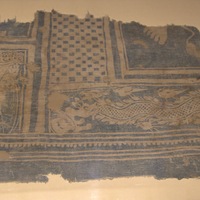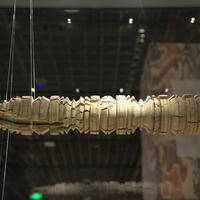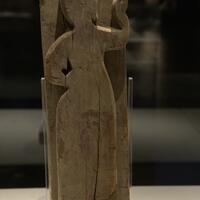Textiles and wood from Niya
Type:
Cities,
Garments,
Grave goods,
Sculptures,
Textiles
Date:
Early third century CE
Location or Findspot (Modern-Day Country):
China
Description:
Niya (Xinjiang province, China) was an oasis city that flourished in the first five centuries CE, disappearing under the sands of the Taklamakan Desert until it was rediscovered in 1901. It has prompted comparisons with Pompeii because of the evidence it preserved for daily life: hundreds of houses, furnishings, coins, clay-sealed letters written on wood in the Karoshthi language, food (wheat, barley, pork, mutton), and a Buddhist stupa (a religious structure containing relics). A carved pillar and a bodhisattva (person on the path to Buddhist enlightenment) relief are shown here, representing the abundant finds in wood.
Niya also preserved the earliest cotton from Central Asia. This blue-and-white fragment, which probably dates to the early third century CE, can be connected with other pieces of a single large cloth found in the same tomb. They were dyed using the resist-dyeing (or wax-resist) technique, in which wax is applied to block the areas of the fabric intended to remain white while the rest was dyed dark blue. At left edge is a haloed nude female holding a cornucopia—an image well known in the Mediterranean region as a personification of Earth or Abundance (as on the Ara Pacis in Rome). She is probably a Central Asian goddess of wealth, recognizable from second-century coins. At the bottom is a scaly dragon, and at the upper right are a human foot and the paw and tail of a lion, perhaps a reference to the story of Hercules or Samson, both of whom fought a lion. The artists who produced the cotton cloth were exposed to Greco-Roman and Chinese imagery by means of portable works traded along the Silk Routes. Even earlier, soldiers fighting with Alexander the Great in the fourth century BCE came very close to Niya; their descendants may have been the blond and brown-haired Caucasian mummies found there.
Silk was both imported from Chinese royal workshops and produced at Niya: dried mulberry trees and a silkworm cocoon were found there. A third-century brocaded (having raised embroidery) silk arm guard (worn by a bowman) bears images of the sun and moon, animals, and the Chinese words "Five stars rise in the east, benefit the Middle Kingdom [China]." A comparable phrase appears in Chinese historical texts of the Han dynasty (206 BCE–220 CE), proclaiming China's place in the world and the importance of astrology.
Niya also preserved the earliest cotton from Central Asia. This blue-and-white fragment, which probably dates to the early third century CE, can be connected with other pieces of a single large cloth found in the same tomb. They were dyed using the resist-dyeing (or wax-resist) technique, in which wax is applied to block the areas of the fabric intended to remain white while the rest was dyed dark blue. At left edge is a haloed nude female holding a cornucopia—an image well known in the Mediterranean region as a personification of Earth or Abundance (as on the Ara Pacis in Rome). She is probably a Central Asian goddess of wealth, recognizable from second-century coins. At the bottom is a scaly dragon, and at the upper right are a human foot and the paw and tail of a lion, perhaps a reference to the story of Hercules or Samson, both of whom fought a lion. The artists who produced the cotton cloth were exposed to Greco-Roman and Chinese imagery by means of portable works traded along the Silk Routes. Even earlier, soldiers fighting with Alexander the Great in the fourth century BCE came very close to Niya; their descendants may have been the blond and brown-haired Caucasian mummies found there.
Silk was both imported from Chinese royal workshops and produced at Niya: dried mulberry trees and a silkworm cocoon were found there. A third-century brocaded (having raised embroidery) silk arm guard (worn by a bowman) bears images of the sun and moon, animals, and the Chinese words "Five stars rise in the east, benefit the Middle Kingdom [China]." A comparable phrase appears in Chinese historical texts of the Han dynasty (206 BCE–220 CE), proclaiming China's place in the world and the importance of astrology.
Relevant Textbook Chapter(s):
1,
2
Image Credits:
Linda Safran





